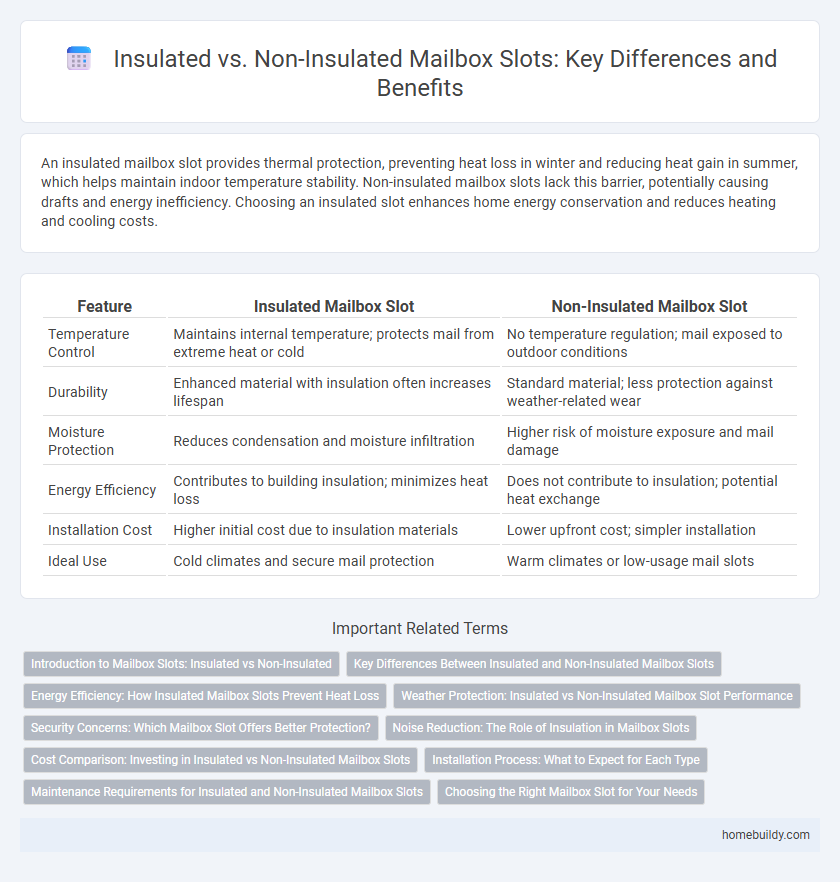An insulated mailbox slot provides thermal protection, preventing heat loss in winter and reducing heat gain in summer, which helps maintain indoor temperature stability. Non-insulated mailbox slots lack this barrier, potentially causing drafts and energy inefficiency. Choosing an insulated slot enhances home energy conservation and reduces heating and cooling costs.
Table of Comparison
| Feature | Insulated Mailbox Slot | Non-Insulated Mailbox Slot |
|---|---|---|
| Temperature Control | Maintains internal temperature; protects mail from extreme heat or cold | No temperature regulation; mail exposed to outdoor conditions |
| Durability | Enhanced material with insulation often increases lifespan | Standard material; less protection against weather-related wear |
| Moisture Protection | Reduces condensation and moisture infiltration | Higher risk of moisture exposure and mail damage |
| Energy Efficiency | Contributes to building insulation; minimizes heat loss | Does not contribute to insulation; potential heat exchange |
| Installation Cost | Higher initial cost due to insulation materials | Lower upfront cost; simpler installation |
| Ideal Use | Cold climates and secure mail protection | Warm climates or low-usage mail slots |
Introduction to Mailbox Slots: Insulated vs Non-Insulated
Insulated mailbox slots provide enhanced protection against temperature fluctuations, preventing mail from being exposed to extreme heat or cold, which helps preserve sensitive documents and parcels. Non-insulated mailbox slots are typically more affordable and easier to install, but they offer less protection from weather elements and temperature changes. Choosing between insulated and non-insulated mailbox slots depends on your climate and the importance of maintaining mail condition.
Key Differences Between Insulated and Non-Insulated Mailbox Slots
Insulated mailbox slots feature a layer of insulating material that helps maintain interior temperature and prevents drafts, making them ideal for climate-controlled environments. Non-insulated mailbox slots lack this thermal barrier, which can lead to cold air infiltration and potential moisture issues inside the mailbox. The choice between insulated and non-insulated slots depends on the balance between energy efficiency and cost, with insulated slots usually offering better protection against weather elements.
Energy Efficiency: How Insulated Mailbox Slots Prevent Heat Loss
Insulated mailbox slots significantly reduce heat loss by creating a thermal barrier that limits air exchange between indoor and outdoor environments, enhancing overall home energy efficiency. The insulation material minimizes drafts and prevents cold air infiltration, which helps maintain consistent indoor temperatures and reduces heating costs during winter months. In contrast, non-insulated mailbox slots allow heat to escape freely, leading to increased energy consumption and decreased thermal comfort.
Weather Protection: Insulated vs Non-Insulated Mailbox Slot Performance
Insulated mailbox slots provide superior weather protection by preventing moisture, cold air, and drafts from entering the home, maintaining internal temperature and safeguarding mail from damage. Non-insulated mailbox slots are more prone to allowing rain, snow, and cold air infiltration, increasing the risk of wet or frozen mail and reduced energy efficiency. Choosing insulated slots enhances durability and energy savings, especially in regions with harsh weather conditions.
Security Concerns: Which Mailbox Slot Offers Better Protection?
Insulated mailbox slots provide enhanced security by reducing the risk of mail theft through tampering and protecting sensitive documents from environmental damage such as moisture and temperature fluctuations. Non-insulated mailbox slots, while simpler and more cost-effective, may be more vulnerable to forced entry and could allow mail to deteriorate due to exposure. Choosing an insulated mailbox slot can significantly improve protection against both theft and weather-related damage, ensuring the security and integrity of your mail.
Noise Reduction: The Role of Insulation in Mailbox Slots
Insulated mailbox slots significantly reduce noise caused by mail dropping, providing a quieter and more peaceful environment compared to non-insulated slots. The insulation material absorbs sound vibrations, minimizing the impact noise and preventing disruption inside the home or office. Choosing an insulated mailbox slot enhances acoustic comfort while maintaining security and mail protection.
Cost Comparison: Investing in Insulated vs Non-Insulated Mailbox Slots
Insulated mailbox slots typically cost 20-30% more than non-insulated options due to advanced materials that provide temperature regulation and energy efficiency. While the initial investment is higher, insulated slots reduce heat loss and protect mail from extreme weather, potentially lowering heating and cooling expenses over time. Non-insulated mailbox slots offer a budget-friendly alternative but lack protection against temperature fluctuations, leading to possible mail damage and increased energy costs.
Installation Process: What to Expect for Each Type
Insulated mailbox slots require careful installation to maintain thermal efficiency, often involving additional sealing materials and insulation layers to prevent drafts and moisture infiltration. Non-insulated mailbox slots have a simpler installation process, typically involving standard mounting without the need for thermal barriers or extra weatherproofing. Expect insulated slots to demand more time and precision to ensure proper insulation performance, whereas non-insulated slots focus primarily on basic fitting and structural stability.
Maintenance Requirements for Insulated and Non-Insulated Mailbox Slots
Insulated mailbox slots require less frequent maintenance due to their ability to regulate temperature and prevent condensation, reducing the risk of rust and damage to mail. Non-insulated mailbox slots often need more regular checks and repairs to address moisture buildup and potential corrosion, especially in harsh weather conditions. Choosing insulated options can extend the lifespan of mailbox slots by minimizing exposure to environmental stressors.
Choosing the Right Mailbox Slot for Your Needs
An insulated mailbox slot effectively reduces heat transfer and protects mail from moisture, making it ideal for regions with extreme temperatures or heavy rainfall. Non-insulated mailbox slots are more cost-effective and easier to install but may allow temperature fluctuations that can damage sensitive mail or cause condensation. Assessing your local climate and mail protection requirements ensures the right mailbox slot choice tailored to your needs.
insulated mailbox slot vs non-insulated mailbox slot Infographic

 homebuildy.com
homebuildy.com